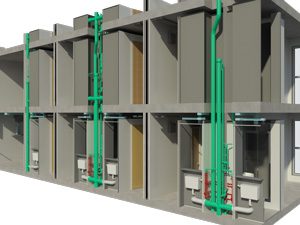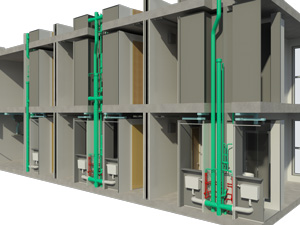Business Information Modelling (BIM) in 2016
We in the UK are in the enviable position of being among the world leaders in BIM adoption and implementation, with the UK Government’s mandate for Level 2 BIM coming into effect in 2016, the industry has been working hard to adopt BIM and achieve BIM compliance. Through BIM the design and construction industries have the tools to create, use and share information effectively, and these tools are considered vital if we are to meet the aims set out within the Government’s construction strategy.
Building Information Modelling, also known as BIM, is specialist software used to generate digital representations of buildings and their physical and functional characteristics. Utilising BIM software can be extremely beneficial during building design and construction and later for facilities management.
The NRB recently published their annual report and in it discussed how BIM compliance across the industry was changing the way the industry works for the better. In 2010, The NRB started monitoring BIM adoption and found that only 13% were using BIM and 43% were unaware of it. 2013 sees a more promising picture, with 54% using BIM and just 5% unaware of it. It shows just how far the industry has come.
BIM is high up on the agenda, with 81% of people surveyed believing that BIM will be a requirement for all public sector work from 2016 and 80% believing that BIM is the future of project information management. It is evident from the report that where possible businesses both large and small need to move towards embracing BIM.
The NRB report suggests that smaller organisations are less confident in their BIM skills. With half of those working in larger organisations describing themselves as ‘confident’ in their knowledge and skills in BIM, this figure drops to a third for smaller organisations. An additional barrier to adoption and implementation of BIM for both smaller and larger organisations is cost; with 67% of smaller organisations and 64% of larger ones stating that the cost of compliance is prohibitive. Additionally a lack of in-house expertise is seen as a barrier across the board, with over three-quarters of larger organisations mentioning it and 62% of smaller ones.
For most businesses in the industry, there is still a long way to go in terms of BIM compliance. The benefits of compliance at every stage of the process are evident, although implementing BIM compliance isn’t easy it is considered to be worth investing in for the long term.
Working with a design team who understand the requirements of BIM and have the skills and know how to implement it in your project can be enormously beneficial, saving your project both time and money. The CAD Room is able to use BIM on any project, allowing all information about that project to flow freely between key stakeholders – from architects to engineers, through to technical specialists, to owners and operators. BIM is the future of information management, are you ready for 2016?
For more information about BIM Compliance and complete 3D CAD services, visit The CAD Room website at https://www.thecadroom.com/or phone 0161 427 0348 with offices in both the UK and UAE we are always happy to help.

